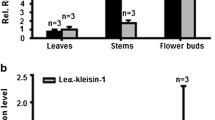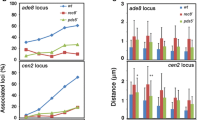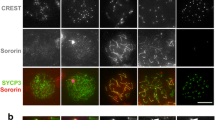Abstract
Proteins of the cohesin complex are essential for sister chromatid cohesion and proper chromosome segregation during both mitosis and meiosis. Cohesin proteins are also components of axial elements/lateral elements (AE/LEs) of synaptonemal complexes (SCs) during meiosis, and cohesins are thought to play an important role in meiotic chromosome morphogenesis and recombination. Here, we have examined the cytological behavior of four cohesin proteins (SMC1, SMC3, SCC3, and REC8/SYN1) during early prophase I in tomato microsporocytes using immunolabeling. All four cohesins are discontinuously distributed along the length of AE/LEs from leptotene through early diplotene. Based on current models for the cohesin complex, the four cohesin proteins should be present at the same time and place in equivalent amounts. However, we observed that cohesins often do not colocalize at the same AE/LE positions, and cohesins differ in when they load onto and dissociate from AE/LEs of early prophase I chromosomes. Cohesin labeling of LEs from pachytene nuclei is similar through euchromatin, pericentric heterochromatin, and kinetochores but is distinctly reduced through the nucleolar organizer region of chromosome 2. These results indicate that the four cohesin proteins may form different complexes and/or perform additional functions during meiosis in plants, which are distinct from their essential function in sister chromatid cohesion.






Similar content being viewed by others
Abbreviations
- 3D-SIM:
-
three-dimensional structured illumination microscopy
- AE:
-
axial element
- CCD:
-
charge coupled device
- DAPI:
-
4’,6-diamidino-2-phenylindole
- DIF1:
-
protein determinant infertile 1
- LE:
-
lateral element
- NOR:
-
nucleolar organizer region
- rDNA:
-
ribosomal DNA
- REC8:
-
meiotic recombination protein REC8
- REC11:
-
meiotic recombination protein REC11
- SMC1:
-
structural maintenance of chromosomes protein 1
- SMC3:
-
structural maintenance of chromosomes protein 3
- SC:
-
synaptonemal complex
- SCC:
-
sister chromatid cohesion
- SCC1:
-
sister chromatid cohesion protein 1
- SCC3:
-
sister chromatid cohesion protein 3
- STAG3:
-
stromalin 3 protein
- SYN1:
-
synaptic mutant
References
Adelfalk C, Janschek J, Revenkova E, Blei C, Leibe B, Göb E, Alsheimer M, Benavente R, de Boer E, Novak I, Höög C, Scherthan H, Jessberger R (2009) Cohesin SMC1β protects telomeres in meiocytes. J Cell Biol 187:185–199
Anderson LK, Stack SM (2005) Recombination nodules in plants. Cytogenet Genome Res 109:198–204
Anderson LK, Covey PA, Larsen LR, Bedinger PA, Stack SM (2010) Structural differences in chromosomes distinguish species in the tomato clade. Cytogenet Genome Res 129:24–34
Austin C, Novikova N, Guacci V, Bellini M (2009) Lampbrush chromosomes enable study of cohesin dynamics. Chomosom Res 17:165–184
Bannister LA, Reinholdt LG, Munroe RJ, Schimenti JC (2004) Positional cloning and characterization of mouse mei8, a disrupted allele of the meiotic cohesin Rec8. Genesis 40:184–194
Brar GA, Hochwagen A, Ee LS, Amon A (2009) The multiple roles of cohesin in meiotic chromosome morphogenesis and pairing. Mol Biol Cell 20:1030–1047
Cai X, Dong F, Edelmann RE, Makaroff CA (2003) The Arabidopsis SYN1 cohesin protein is required for sister chromatid arm cohesion and homologous chromosome pairing. J Cell Sci 116:2999–3007
Chan RC, Chan A, Jeon M, Wu TF, Pasqualone D, Rougvie AE, Meyer BJ (2003) Chromosome cohesion is regulated by a clock gene paralogue TIM-1. Nature 423:1002–1009
Chang S-B, Yang T-J, Datema E, Vugt Jv, Vosman B, Kuipers A, Meznikova M, Szinay D, Lankhorst RK, Jacobsen E, de Jong H (2008) FISH mapping and molecular organization of the major repetitive sequences of tomato. Chomosom Res 16:919–933
Chelysheva L, Diallo S, Vezon D, Gendrot G, Vrielynck N, Belcram K, Rocques N, Marquez-Lema A, Bhatt AM, Horlow C, Mercier R, Mezard C, Grelon M (2005) AtREC8 and AtSCC3 are essential to the monopolar orientation of the kinetochores during meiosis. J Cell Sci 118:4621–4632
Ding D-Q, Sakurai N, Katou Y, Itoh T, Shirahige K, Haraguchi T, Hiraoka Y (2006) Meiotic cohesins modulate chromosome compaction during meiotic prophase in fission yeast. J Cell Biol 174:499–508
Dong F, Cai X, Makaroff CA (2001) Cloning and characterization of two Arabidopsis genes that belong to the RAD21/REC8 family of chromosome cohesin proteins. Gene 271:99–108
Eijpe M, Heyting C, Gross B, Jessberger R (2000) Association of mammalian SMC1 and SMC3 proteins with meiotic chromosomes and synaptonemal complexes. J Cell Sci 113:673–682
Eijpe M, Offenberg HH, Jessberger R, Revenkova E, Heyting C (2003) Meiotic cohesin REC8 marks the axial elements of rat synaptonemal complexes before cohesins SMC1β and SMC3. J Cell Biol 160:657–670
Ellermeier C, Smith GR (2005) Cohesins are required for meiotic DNA breakage and recombination in Schizosaccharomyces pombe. Proc Natl Acad Sci USA 102:10952–10957
Golubovskaya IN, Hamant O, Timofejeva L, Wang C JR, Braun D, Meeley R, Cande WZ (2006) Alleles of afd1 dissect Rec8 functions during meiotic prophase I. J Cell Sci 119:3315
Guacci V (2007) Sister chromatid cohesion: the cohsin cleavage model does not ring true. Genes Cells 12:693–708
Gustafsson MGL, Shao L, Carlton PM, Wang C-J, Golubovskaya IN, Cande WZ, Agard DA, Sedat JW (2008) Three-dimensional resolution doubling in wide-field fluorescence microscopy by structured illumination. Biophys J 94:4957–4970
Heidinger-Pauli JM, Mert O, Davenport C, Guacci V, Koshland D (2010) Systematic reduction of cohesin differentially affects chromosome segregation, condensation, and DNA repair. Curr Biol 20:957–963
Hirano T (2002) The ABCs of SMC proteins: two-armed ATPases for chromosome condensation, cohesion, and repair. Genes Dev 16:399–414
Hodges CA, Revenkova E, Jessberger R, Hassold TJ, Hunt PA (2005) SMC1β-deficient female mice provide evidence that cohesins are a missing link in age-related nondisjunction. Nat Genet 37:1351–1355
Kim KP, Weiner BM, Zhang L, Jordan A, Dekker J, Kleckner N (2010) Sister cohesion and structural axis components mediate homolog bias of meiotic recombination. Cell 143:924–937
Kitajima TS, Yokobayashi S, Yamamoto M, Watanabe Y (2003) Distinct cohesin complexes organize meiotic chromosome domains. Science 300:1152–1155
Klein F, Mahr P, Galova M, Buonomo SBC, Michaelis C, Nairz K, Nasmyth K (1999) A central role for cohesins in sister chromatid cohesion, formation of axial elements, and recombination during yeast meiosis. Cell 98:91–103
Ku H-M, Vision TJ, Liu J, Tanksley SD (2000) Comparing sequenced segments of the tomato and Arabidosis genomes: large-scale duplication followed by selective gene loss creates a network of synteny. Proc Natl Acad Sci USA 97:9121–9126
Kudo NR, Wassmann K, Anger M, Schuh M, Wirth KG, Xu H, Helmhart W, Kudo H, Mckay M, Maro B, Ellenberg J, de Boer P, Nasmyth K (2006) Resolution of chiasmata in oocytes requires separase-mediated proteolysis. Cell 126:135–146
Kudo NR, Anger M, Peters AHFM, Stemmann O, Theussl HC, Helmhart W, Kudo H, Heyting C, Nasmyth K (2009) Role of cleavage by separase of the Rec8 kleisin subunit of cohesin during mammalian meiosis I. J Cell Sci 122:2686–2698
Lam WS, Yang X, Makaroff CA (2005) Characterization of Arabidopsis thaliana SMC1 and SMC3: evidence that AtSMC3 may function beyond chromosome cohesion. J Cell Sci 118:3037–3048
Lhuissier FGP, Offenberg HH, Wittich PE, Vischer NOE, Heyting C (2007) The mismatch repair protein MLH1 marks a subset of strongly interfering crossovers in tomato. Plant Cell 19:862–876
Lohmiller LD, De Muyt A, Howard B, Offenberg HH, Heyting C, Grelon M, Anderson LK (2008) Cytological analysis of MRE11 protein during early meiotic prophase I in Arabidopsis and tomato. Chromosoma 117:277–288
Losada A, Hirano T (2005) Dynamic molecular linkers of the gnome: the first decade of SMC proteins. Genes Dev 19:1269–1287
Maguire MP (1978) A possible role for the synaptonemal complex in chiasma maintenance. Exp Cell Res 112:297–308
Maguire MP (1995) Is the synaptonemal complex a disjunction machine? J Heredity 86:330–340
Manheim EA, McKim KS (2003) The synaptonemal complex component C(2)M regulates meiotic crossing over in Drosophila. Curr Biol 13:276–285
Molnar M, Bahler J, Sipiczki M, Kohli J (1995) The rec8 gene of Schizosaccharomyces pombe is involved in linear element formation, chromosome pairing and sister-chromatid cohesion during meiosis. Genetics 141:61–73
Mueller LA, Tanksley S, Giovannoni JJ, Vaneck J, Stack S, Buels R (2009) A snapshot of the emerging tomato genome sequence. The Plant Genome 2:78–92
Nasmyth K (2001) Disseminating the genome: joining, resolving, and separating sister chromatids during mitosis and meiosis. Annu Rev Genet 35:673–745
Nasmyth K, Haering CH (2009) Cohesin: its roles and mechanisms. Annu Rev Genet 43:525–558
Novak I, Wang H, Revenkova E, Jessberger R, Scherthan H, Höög C (2008) Cohesin Smc1β determines meiotic chromatin axis loop organization. J Cell Biol 180:83–90
Onn I, Heidinger-Pauli JM, Guacci V, Ünal E, Koshland DE (2008) Sister chromatid cohesion: a simple concept with a complex reality. Annu Rev Cell Dev Biol 24:105–129
Page SL, Hawley RS (2004) The genetics and molecular biology of the synaptonemal complex. Annu Rev Cell Dev Biol 20:525–558
Page J, de la Fuenta R, Gomez R, Calvente A, Viera A, Parra MT, Santos JL, Berríos S, Fernandez-Donoso R, Suja JA, Rufas JS (2006) Sex chromosomes, synapsis, and cohesins: a complex affair. Chromosoma 115:250–259
Parisi S, McKay MJ, Molnar M, Thompson DA, van der Spek PJ, van Drunen-Schoenmaker E, Kanaar R, Lehmann E, Hoeijmakers JHJ, Kohli J (1999) Rec8p, a meiotic recombination and sister chromatid cohesion phosphoprotein of the Rad21p family conserved from fission yeast to humans. Mol Cell Biol 19:3515–3528
Pasierbek P, Jantsch M, Melcher M, Schleiffer A, Schweizer D, Loidl J (2001) A Caenorhabiditis elegans cohesion protein with functions in meiotic chromosome pairing and disjunction. Genes Dev 15:1349–1360
Pasierbek P, Födermayr M, Jantsch V, Jantsch M, Schweizer D, Loidl J (2003) The Caenorhabditis elegans SCC-3 homolgue is required for meiotic synapsis and for proper chromosome disjunction in mitosis and meiosis. Exp Cell Res 289:245–255
Peters J-M, Tedeschi A, Schmitz J (2008) The cohesin complex and its roles in chromosome biology. Genes Dev 22:3089–3114
Peterson DG, Price HJ, Johnston JS, Stack SM (1996) DNA content of heterochromatin and euchromatin in tomato (Lycopersicon esculentum) pachytene chromosomes. Genome 39:77–82
Petronczki M, Siomos MF, Nasmyth K (2003) Un ménage á Quatre: the molecular biology of chromosome segregation in meiosis. Cell 112:423–440
Pezzi N, Prieto I, Kremer L, del Mazo J, Valero C, del Mazo J, Martínez-A C, Barbero JL (2000) STAG3, a novel gene encoding a protein involved in meiotic chromosome pairing and location of STAG3-related genes flanking the Williams-Beuren syndrome deletion. FASEB J 14:581–592
Pigozzi MI, Solari AJ (2003) Differential immunolocalization of a putative Rec8p in meiotic autosomes and sex chromosomes of triatomine bugs. Chromosoma 112:38–47
Prieto I, Suja JA, Pezzi N, Kremer L, Martinez-A C, Rufas JS, Barbero JL (2001) Mammalian STAG3 is a cohesin specific to sister chromatid arms in meiosis I. Nat Cell Biol 3:761–766
Prieto I, Pezzi N, Buesa JM, Kremer L, Barthelemy I, Carreiro C, Roncal F, Martínez A, Gómez L, Fernández R, Martínez-A C, Barbero JL (2002) STAG2 and Rad21 mammalian mitotic cohesins are implicated in meiosis. EMBO Rep 3:543–550
Revenkova E, Jessberger R (2006) Shaping meiotic prophase chromosomes: cohesins and synaptonemal complex proteins. Chromosoma 115:235–240
Revenkova E, Eijpe M, Heyting C, Gross B, Jessberger R (2001) Novel meiosis-specific isoform of mammalian SMC1. Mol Cell Biol 21:6984–6998
Schermelleh L, Carlton PM, Haase S, Shao L, Winoto L, Kner P, Burke B, Cardoso MC, Agard DA, Gustafsson MGL, Leonhardt H, Sedat JW (2008) Subdiffraction multicolor imaging of the nuclear periphery with 3D structured illumination microscopy. Science 320:1332–1336
Schleiffer A, Kaitna S, Maurer-Stroh S, Glotzer M, Nasmyth K, Eisenhaber F (2003) Kleisins: a superfamily of bacterial and eukaryotic SMC protein partners. Mol Cell 11:571–575
Schubert V (2009) SMC proteins and their multiple functions in higher plants. Cytogenet Genome Res 124:202–214
Severson AF, Ling L, van Zuylen V, Meyer BJ (2009) The axial element protein HTP-3 promotes cohesin loading and meiotic axis assembly in C. elegans to implement the meiotic program of chromosome segregation. Genes Dev 23:1763–1778
Sherman JD, Stack SM (1992) Two-dimensional spreads of synaptonemal complexes from solanaceous plants. V. Tomato (Lycopersicon esculentum) karyotype and idiogram. Genome 35:354–359
Sherman JD, Stack SM (1995) Two-dimensional spreads of synaptonemal complexes from solanaceous plants. VI. High-resolution recombination nodule map for tomato (Lycopersicon esculentum). Genetics 141:683–708
Skibbens RV (2009) Establishment of sister chromatid cohesion. Curr Biol 19:R1126–R1132
Stack SM, Anderson LK (2009) Electron microscopic immunogold localization of recombination-related proteins in spreads of synaptonemal complexes from tomato microsporocytes. In: Meiosis: volume 2, cytological methods. Humana Press, Inc., Totowa, pp 147–169
Stack SM, Royer SM, Shearer LA, Chang S-B, Giovannoni JJ, Westfall DH, White RA, Anderson LK (2009) Role of fluorescence in situ hybridization in sequencing the tomato genome. Cytogenet Genome Res 124:339–350
Suja JA, Barbero JL (2009) Cohesin complexes and sister chromatid cohesion in mammalian meiosis. In: Meiosis. Karger, Basel, pp 94–116
Sumara I, Vorlaufer E, Gieffers C, Peters BH, Peters J-M (2000) Characterization of vertebrate cohesin complexes and their regulation in prophase. J Cell Biol 151:749–761
Surcel A, Koshland D, Ma H, Simpson RT (2008) Cohesin interaction with centromeric minichromosomes shows a multi-complex rod-shaped structure. PLoS ONE 3:e2453
The Arabidopsis Genome Initiative (2000) Analysis of the genome sequence of the flowering plant Arabidopsis thaliana. Nature 408:796–815
Uhlmann F (2009) A matter of choice: the establishment of sister chromatid cohesion. EMBO Rep 10:1095–1102
Valdeolmillos AM, Viera A, Page J, Prieto I, Santos JL, Parra MT, Heck MMS, Martinez-A C, Barbero JL, Suja JA, Rufas JS (2007) Sequential loading of cohesin subunits during the first meiotic prophase of grasshoppers. PLoS Genetics 3:e28. doi:10.1371/journal.pgen.0030028
van Heemst D, Heyting C (2000) Sister chromatid cohesion and recombination in meiosis. Chromosoma 109:10–26
Wang C JR, Carlton PM, Golubovskaya IN, Cande WZ (2009) Interlock formation and coiling of meiotic chromosome axes during synapsis. Genetics 183:905–915
Wang M, Wang K, Tang D, Wei C, Li M, Shen Y, Chi Z, Gu M, Cheng Z (2010) The central element protein ZEP1 of the synaptonemal complex regulates the number of crossovers during meiosis in rice. Plant Cell 22:417–430
Watanabe Y, Nurse P (1999) Cohesin Rec8 is required for reductional chromosome segregation at meiosis. Nature 400:461–464
Xiong B, Gerton JL (2010) Regulators of the cohesin network. Ann Rev Biochem 79:131–153
Xu H, Beasley MD, Warren WD, van der Horst GTJ, McKay MJ (2005) Absence of mouse REC8 cohesin promotes synapsis of sister chromatids in meiosis. Devel Cell 8:949–961
Zhang L, Tao J, Wang S, Chong K, Wang T (2006) The rice OsRad21-4, an orthologue of yeast Rec8 proteins, is required for efficient meiosis. Plant Mol Biol 60:533–554
Zickler D, Kleckner N (1999) Meiotic chromosomes: integrating structure and function. Annu Rev Genet 33:603–754
Acknowledgments
We thank Chris Makaroff (University of Miami, Ohio) and Christine Mezard and Liudmila Chelysheva (Versailles, France) for generously providing antibodies to AtSYN1 and AtSCC3, respectively. We also thank two anonymous reviewers for their helpful comments. This work was supported by the National Science Foundation (MCB-064344 and MCB-1019708).
Author information
Authors and Affiliations
Corresponding author
Additional information
Responsible Editor: Jiming Jiang
Rights and permissions
About this article
Cite this article
Qiao, H., Lohmiller, L.D. & Anderson, L.K. Cohesin proteins load sequentially during prophase I in tomato primary microsporocytes. Chromosome Res 19, 193–207 (2011). https://doi.org/10.1007/s10577-010-9184-1
Received:
Revised:
Accepted:
Published:
Issue Date:
DOI: https://doi.org/10.1007/s10577-010-9184-1




